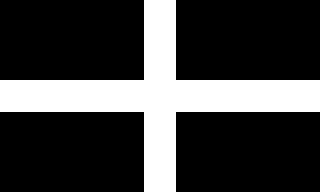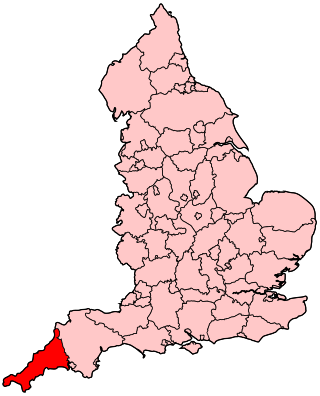
Bodmin is a town and civil parish in Cornwall, England, United Kingdom. It is situated south-west of Bodmin Moor.

The Lizard is a peninsula in southern Cornwall, England, United Kingdom. The most southerly point of the British mainland is near Lizard Point at SW 701115; Lizard village, also known as The Lizard, is the most southerly on the British mainland, and is in the civil parish of Landewednack, the most southerly parish. The valleys of the River Helford and Loe Pool form the northern boundary, with the rest of the peninsula surrounded by sea. The area measures about 14 by 14 miles. The Lizard is one of England's natural regions and has been designated as a National Character Area 157 by Natural England. The peninsula is known for its geology and for its rare plants and lies within the Cornwall Area of Outstanding Natural Beauty (AONB).
Year 1497 (MCDXCVII) was a common year starting on Sunday of the Julian calendar.

Perkin Warbeck was a pretender to the English throne claiming to be Richard of Shrewsbury, Duke of York, who was the second son of Edward IV and one of the so-called "Princes in the Tower". Richard, were he alive, would have been the rightful claimant to the throne, assuming that his elder brother Edward V was dead and that he was legitimate—a point that had been previously contested by his uncle, King Richard III.

The Prayer Book Rebellion or Western Rising was a popular revolt in Cornwall and Devon in 1549. In that year, the Book of Common Prayer, presenting the theology of the English Reformation, was introduced. The change was widely unpopular, particularly in areas where firm Catholic religious loyalty still existed, such as Lancashire. Along with poor economic conditions, the enforcement of the English language literature rather than Cornish led to an explosion of anger in Cornwall and Devon, initiating an uprising. In response, Edward Seymour, 1st Duke of Somerset sent John Russell to suppress the revolt, with the rebels being defeated and its leaders executed two months after the beginning of hostilities.

Michael Joseph, better known as Michael An Gof, was one of the leaders of the Cornish rebellion of 1497, along with Thomas Flamank.

St Keverne is a civil parish and village on The Lizard in Cornwall, England, United Kingdom.

The Cornish rebellion of 1497, also known as the First Cornish rebellion, was a popular uprising in the Kingdom of England, which began in Cornwall and culminated with the Battle of Deptford Bridge near London on 17 June 1497.
Sir Robert Constable was a member of the English Tudor gentry. He helped Henry VII to defeat the Cornish rebels at the Battle of Blackheath in 1497. In 1536, when the rising known as the Pilgrimage of Grace broke out in the north of England, Constable was one of the insurgent leaders, but towards the close of the year, he submitted at Doncaster and was pardoned. He did not share in the renewal of the rising, Bigod's rebellion, which took place in January 1537; but he refused the king's invitation to proceed to London, and was arrested, tried for treason, and hanged at Hull in the following June.

Humphrey Arundell of Helland in Cornwall, was the leader of Cornish forces in the Prayer Book Rebellion early in the reign of King Edward VI. He was executed at Tyburn, London after the rebellion had been defeated.
This timeline summarizes significant events in the History of Cornwall

James Tuchet, 7th Baron Audley was a British nobleman and the only lord to fully join the Cornish rebellion of 1497 opposing the rule of Henry VII of England. He was a leader in the rebel army's march to the edge of London, and in its defeat at the Battle of Deptford Bridge. Captured on the battlefield, he was sentenced for treason and beheaded. His peerage was forfeited, but restored to his son in 1512.
Events from the 1490s in England.
The Second Cornish uprising occurred in September 1497 when the pretender to the throne Perkin Warbeck landed at Whitesand Bay, near Land's End, on 7 September with just 120 men in two ships.

Giles Daubeney, 1st Baron Daubeney, KG PC was an English soldier, diplomat, courtier and politician.

Cornish devolution is the movement to increase the governing powers of the County of Cornwall.
John Flamank or Flamoke, of Boscarne, near Bodmin, Cornwall, was an English politician.
Gilbert Flamank or Flamoke, of Boscombe near Bodmin, Cornwall, was an English politician.

The following outline is provided as an overview of and topical guide to Cornwall: Cornwall – ceremonial county and unitary authority area of England within the United Kingdom. Cornwall is a peninsula bordered to the north and west by the Celtic Sea, to the south by the English Channel, and to the east by the county of Devon, over the River Tamar. Cornwall is also a royal duchy of the United Kingdom. It has an estimated population of half a million and it has its own distinctive history and culture.
Presented below is an alphabetical index of articles related to Cornwall:














